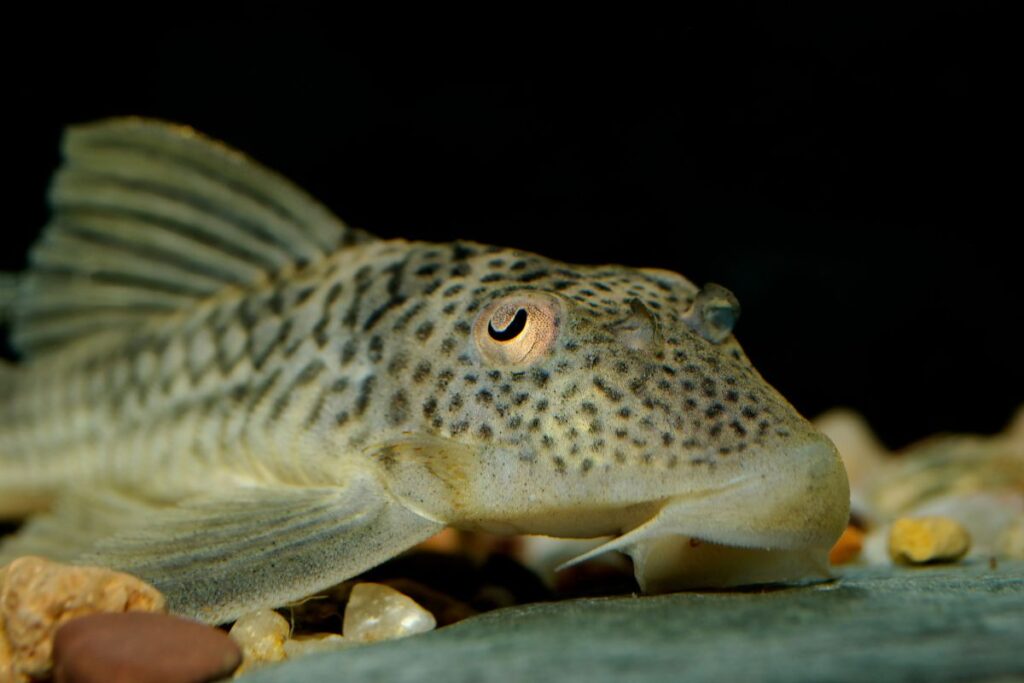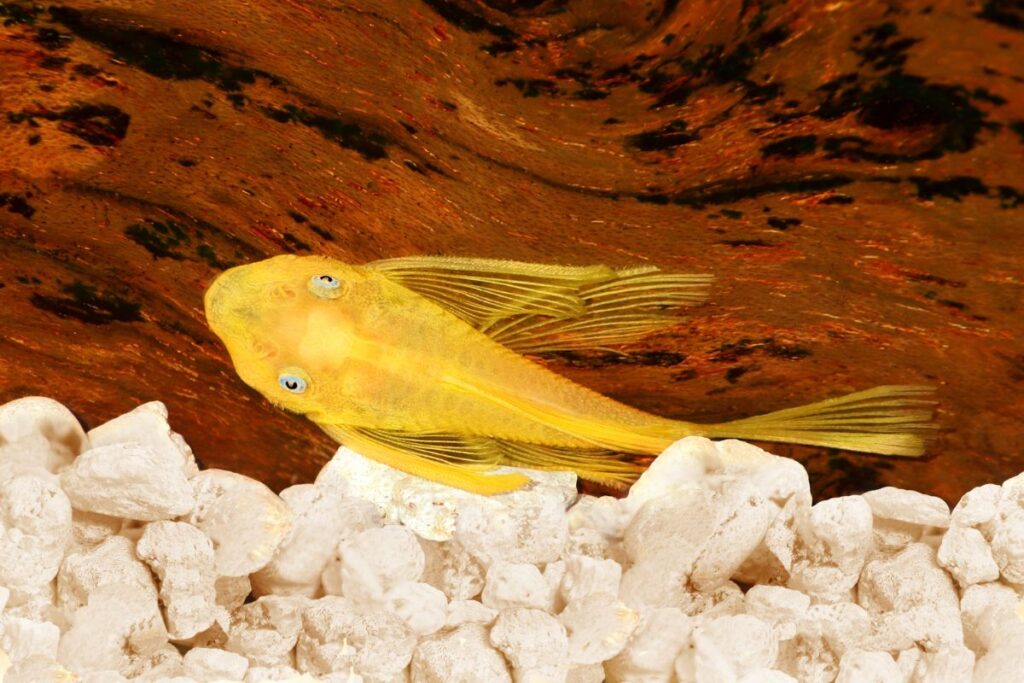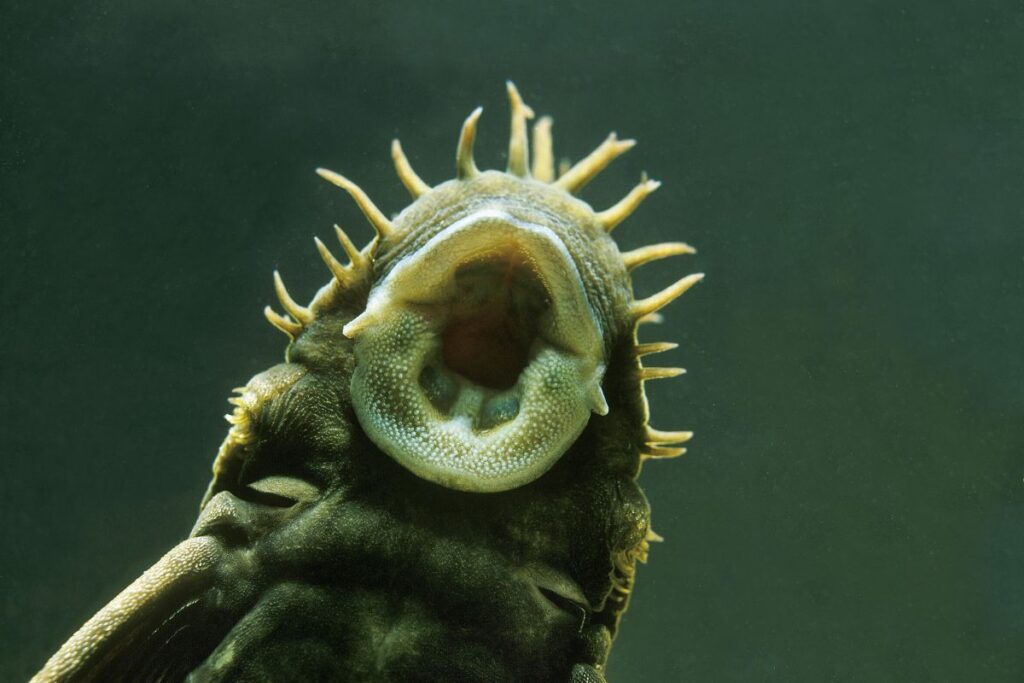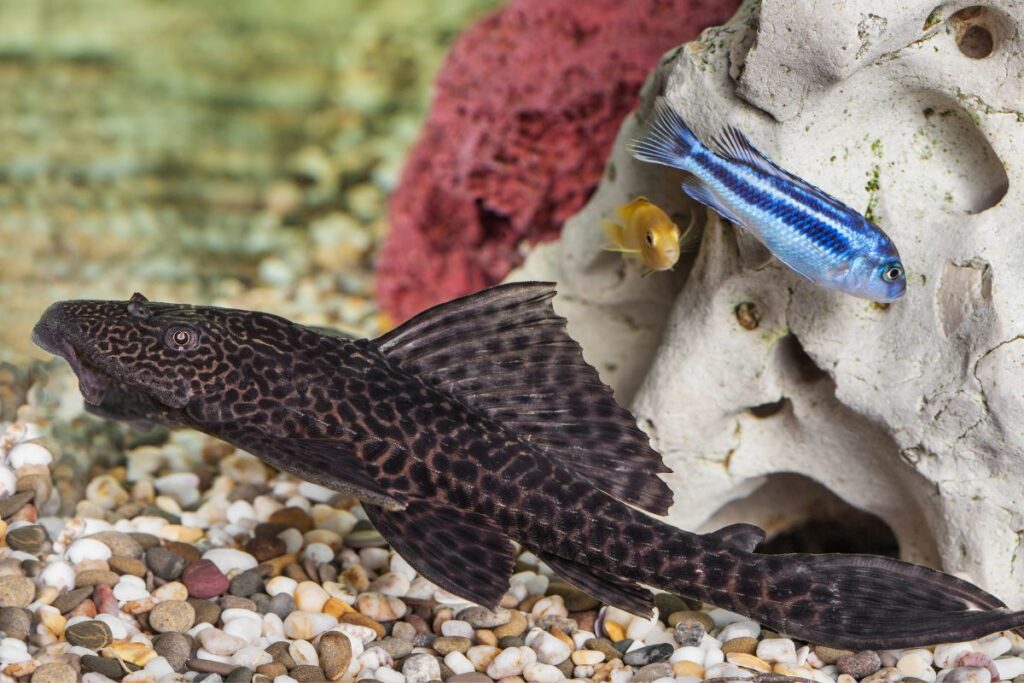Have you ever considered keeping a pleco in your aquarium? These fascinating fish are a popular choice for many aquarium owners. They are known for their unique appearance, hardy nature, and their ability to keep tanks clean. In this article, we will cover everything you need to know about plecos, from their natural habitat to their diet and care requirements.
To care for plecos, provide a spacious tank, good water quality, and a varied diet that includes algae wafers, vegetables, and protein sources. Maintain a regular day/night cycle and monitor the water temperature, pH, and ammonia levels. Provide hiding places and a suitable substrate for plecos to rest on. Clean the tank regularly and avoid overfeeding.
As an aquarium enthusiast, I have had the pleasure of keeping plecos for many years. These fish are not only beautiful to look at, but they also provide many benefits to your tank. Plecos are known as “algae eaters” and can help keep your tank clean by eating algae and other debris. They are also hardy fish that can tolerate a wide range of water conditions, making them a great choice for beginners and experienced aquarists alike.
In this article, we will dive into the world of plecos and explore their unique characteristics, care requirements, and how to choose the right pleco for your tank. Whether you are a seasoned aquarium owner or just starting out, this article will provide you with all the information you need to know about plecos.

Table of Contents
Key Takeaways:
- Plecos are freshwater fish that are popular among aquarium enthusiasts due to their unique appearance and helpful behavior.
- Plecos are known as “algae eaters” and can help keep tanks clean by eating algae and other debris.
- Plecos are hardy fish that can tolerate a wide range of water conditions, making them a great choice for beginners and experienced aquarists alike.
- Plecos prefer slow-moving water with plenty of hiding places, like rocks and logs, and a substrate that allows them to burrow.
- Plecos are primarily herbivores and eat algae and other plant matter, but can also be fed sinking pellets and vegetables.
- Common types of plecos include the Common Pleco, Bristlenose Pleco, and Rubber Lip Pleco.
- When caring for plecos, it’s important to provide them with a tank that mimics their natural environment, including plenty of hiding spots, a dimly lit environment, and well-filtered water.
- Signs of a healthy plecostomus include a plump, round belly, clear, bright eyes, and active swimming behavior.
- Common health issues in plecos include ich, fin rot, bacterial infections, and constipation.
- When choosing tank mates for plecos, it’s important to consider their size, behavior, and water requirements.
- If interested in breeding plecos, a separate breeding tank should be set up with plenty of hiding places and a flat surface for the plecos to lay their eggs.
- Plecos can make wonderful additions to any aquarium with their unique personalities and beautiful appearance.
What are Plecos?
When I first started my aquarium hobby, I was fascinated by the different types of fish I could keep. One of the most interesting species that caught my attention was the pleco.
Plecos are a type of freshwater fish that are popular among aquarium enthusiasts because of their unique appearance and helpful behavior.
Appearance
Plecos are known for their distinctive appearance. They have a flattened body with a large head and a sucker mouth that they use to attach themselves to surfaces.
Their bodies are covered in bony plates that protect them from predators. They come in a variety of colors and patterns, including brown, black, and white, and can grow up to several feet in length.
Adult size
The size of a pleco depends on the species. Some species, like the bristlenose pleco, only grow to be a few inches long, while others, like the common pleco, can reach up to two feet in length.
Growth Rate & Lifespan of popular species
The growth rate and lifespan of a pleco also vary depending on the species. The common pleco, for example, can grow up to two inches per month and live for up to 15 years.
The bristlenose pleco, on the other hand, grows at a slower rate and has a lifespan of around 5 years.
Behavior
Plecos are known for their helpful behavior in aquariums. They are bottom feeders, which means they eat algae and other debris that collects on the bottom of the tank. They are also nocturnal, which means they are most active at night.
Natural Habitat
Plecos are native to South America, where they live in rivers and streams. They prefer slow-moving water with plenty of hiding places, like rocks and logs.
Characteristics
One of the most interesting characteristics of plecos is their ability to regenerate their fins. If a pleco loses a fin, it will grow back over time.
Plecos are also known for their ability to survive in a variety of water conditions, including low oxygen levels and high levels of pollutants.
Habitat
When keeping plecos in an aquarium, it’s important to provide them with a habitat that mimics their natural environment.
This means including plenty of hiding places, like rocks and caves, and providing a substrate that allows them to burrow.
Diet
Plecos are primarily herbivores and eat algae and other plant matter. They can also be fed sinking pellets and vegetables like zucchini and cucumber.
Types of Plecos
| Species | Adult Size | Growth Rate | Lifespan | Behavior |
|---|---|---|---|---|
| Common Pleco | Up to 2 ft | Up to 2 in/month | Up to 15 yrs | Algae eater, can produce a lot of waste |
| Bristlenose Pleco | Up to 5 in | Slower growth | Up to 5 yrs | Algae eater, smaller and more manageable |
| Rubber Lip Pleco | Up to 4 in | Slower growth | Up to 5 yrs | Algae eater, peaceful addition to community tank |
Common Pleco
The Common Pleco is one of the most popular types of plecos in the aquarium hobby. They are known for their large size, reaching up to 2 feet in length, and their ability to eat algae and leftover food.
However, they also produce a lot of waste and require a larger tank to accommodate their size.
Bristlenose Pleco
The Bristlenose Pleco is a smaller and more manageable alternative to the Common Pleco. They are known for their distinctive bristles on their nose and are excellent at cleaning algae in the tank.
They only grow up to 5 inches in length and are a great addition to any community tank.
Rubber Lip Pleco
The Rubber Lip Pleco is another popular type of pleco. They are known for their rubbery lips that they use to scrape algae off surfaces.
They are a smaller species, growing up to 4 inches in length, and are a peaceful addition to any community tank.
In my experience, I have found that the Bristlenose Pleco is the easiest and most manageable type of pleco to keep in a home aquarium.
They are hardy and can adapt to a variety of water conditions. Plus, their bristles give them a unique and interesting appearance in the tank.
Caring for Plecos
| Requirement | Details |
|---|---|
| Tank Size | At least 75 gallons |
| Substrate | Sandy substrate for digging and sifting |
| Hiding Spots | Caves, driftwood, PVC pipes |
| Light | Dimly lit tank with some areas of shade |
| Water | Slightly acidic water with pH between 6.5-7.5, well-filtered and free of ammonia and nitrite |
| Feeding | Algae wafers or pellets, fresh vegetables like zucchini or cucumber |

Tank Setup
When setting up a tank for plecos, it’s important to consider their size and behavior. Plecos can grow quite large, so a tank of at least 75 gallons is recommended.
They also need plenty of hiding spots, such as caves or driftwood, to feel secure. A sandy substrate is ideal, as plecos like to dig and sift through the sand for food.
Light Requirement
Plecos are nocturnal creatures, so they don’t require a lot of light. In fact, too much light can stress them out. A dimly lit tank with some areas of shade is best.
You can also use a moonlight or blue light to simulate their natural habitat.
Hiding Spots
As mentioned earlier, plecos need plenty of hiding spots to feel secure. This can be achieved with caves, driftwood, or even PVC pipes.
Providing hiding spots will also help reduce stress and aggression between plecos and other fish in the tank.
Water Conditions
Plecos are hardy fish, but they do have some specific water requirements. They prefer slightly acidic water with a pH between 6.5 and 7.5.
The water should also be well-filtered and free of ammonia and nitrite. Plecos are also sensitive to high levels of nitrates, so regular water changes are important.
Feeding
Plecos are omnivores and will eat a variety of foods. A staple diet of algae wafers or pellets is recommended, along with fresh vegetables such as zucchini or cucumber.
It’s important not to overfeed plecos, as they can become obese and develop health problems.
Cleaning
Regular tank maintenance is important for the health of your plecos. This includes weekly water changes, cleaning the substrate, and removing any uneaten food.
Plecos produce a lot of waste, so a good filtration system is essential.
Personally, I’ve found that plecos are fascinating fish to keep. They have a lot of personality and are fun to watch as they sift through the sand or hang out in their hiding spots. With a little bit of care and attention, they can thrive in a home aquarium.
Health

| Health Indicator | Healthy Plecostomus | Unhealthy Plecostomus |
|---|---|---|
| Belly | Plump, round | Sunken |
| Eyes | Clear, bright | Cloudy, dull |
| Fins | Erect | Clamped to body |
| Activity | Active, swimming | Lethargic, floating or sinking |
| Appetite | Good appetite | Loss of appetite |
Signs of a healthy plecostomus
A healthy plecostomus should have a plump, round belly and clear, bright eyes. Its fins should be erect and not clamped to its body.
The fish should be active and swim around the tank with ease. A healthy pleco will also have a good appetite and eat regularly.
Signs of an unhealthy plecostomus
When a plecostomus is sick, it may show signs of lethargy, loss of appetite, and weight loss. Its fins may be clamped to its body, and its belly may appear sunken.
Other signs of illness include abnormal swimming behavior, such as floating or sinking to the bottom of the tank, and gasping for air at the surface.
Common Health Issues: Signs, Treatment & Prevention
| Health Issue | Signs | Treatment |
|---|---|---|
| Ich | White spots on body | Medication designed for freshwater fish |
| Fin rot | Fins deteriorating | Keep water clean, medication to prevent further infection |
| Bacterial infections | Various symptoms | Antibiotics |
| Constipation | Bloated belly, loss of appetite | Fiber-rich diet, blanched zucchini or spinach |
One common health issue in plecos is ich, a parasitic infection that causes white spots on the fish’s body. Other common health issues include fin rot, bacterial infections, and constipation.
If you notice any signs of illness in your plecostomus, it’s important to take action right away.
To treat ich, you can use a medication designed for freshwater fish. For bacterial infections, you may need to use antibiotics. Fin rot can be treated by keeping the water clean and using a medication to prevent further infection.
To prevent health issues in plecos, it’s important to maintain a clean and healthy environment in the tank. This includes regular water changes, proper filtration, and a balanced diet.
Personally, I had a plecostomus that suffered from constipation. I noticed that it wasn’t eating as much as usual and its belly appeared bloated.
After doing some research, I learned that feeding the fish a diet rich in fiber could help. I started feeding my pleco blanched zucchini and spinach, and within a few days, it was back to its normal, healthy self.
Tank Mates

If you’re planning on keeping a pleco in your aquarium, it’s important to choose the right tank mates. While plecos are generally peaceful fish, they can be territorial and may become aggressive towards other fish that invade their space.
Here are a few things to keep in mind when selecting tank mates for your pleco:
- Size: Plecos can grow quite large, so it’s important to choose tank mates that won’t be intimidated or threatened by their size. Avoid keeping plecos with smaller fish that may be seen as prey.
- Behavior: Plecos are bottom dwellers and tend to be more active at night. Choose tank mates that occupy different levels of the aquarium and have different activity patterns to avoid overcrowding and competition for resources.
- Water Conditions: Plecos prefer warm, slightly acidic water. Choose tank mates that have similar water requirements to avoid stress and health problems.
Personally, I’ve had success keeping plecos with other bottom-dwelling fish like corydoras and loaches. These fish occupy different levels of the aquarium and have different activity patterns, which makes for a harmonious tank environment.
However, it’s important to do your research and choose tank mates that are compatible with your pleco’s specific needs and temperament.
Breeding Plecos
Breeding Setup
If you’re interested in breeding plecos, you’ll need to set up a separate breeding tank. This tank should be at least 20 gallons, with plenty of hiding places for the plecos to lay their eggs.
You’ll also need to provide a flat surface for the plecos to lay their eggs on, such as a piece of slate or a clay pot.
Keep the water temperature between 78-82°F and the pH between 6.5-7.5. Make sure to use a sponge filter to keep the water clean and oxygenated.
Breeding Process
Once your breeding setup is ready, you can introduce your plecos. It’s best to have a male and female pleco in the tank, and they should be well-fed with a variety of foods.
The male pleco will begin to clean the breeding surface and attract the female with his pheromones. The female will lay her eggs on the breeding surface, and the male will fertilize them. After laying her eggs, the female will leave the breeding tank.
Raising Fry
After a few days, the eggs will hatch into fry. The fry will initially feed on their yolk sacs, but you can supplement their diet with baby brine shrimp or crushed flakes.
Keep the water clean by performing daily water changes of 10-20%. As the fry grow, you may need to separate them into a larger tank to prevent overcrowding. It can take up to a year for plecos to reach sexual maturity.
Personally, I found breeding plecos to be a rewarding and fascinating experience. Watching the male and female interact and seeing the eggs hatch into tiny fry was a truly memorable experience.
With the right setup and care, you too can breed plecos and enjoy the wonder of these incredible fish.
Recommended Products As Per The Article:
- Hikari Algae Wafers – These algae wafers are a great food choice for plecos as they are specifically designed for herbivorous fish and contain high levels of spirulina and other plant matter.
- Aqueon Aquarium 20 Gallon Tank: This tank is a great size for pleco fish and provides ample space for them to swim and explore. It has a clear glass design that allows for easy viewing and comes with a LED light hood.
- Seachem Prime – This water conditioner is essential for maintaining a healthy tank environment for your plecos. It detoxifies ammonia, nitrite, and nitrate, and helps to protect your fish from harmful chemicals.
- Penn Plax Hideaway Pipes – These PVC pipes are a great hiding spot for plecos and other bottom-dwelling fish. They provide a safe and secure place for your fish to rest and reduce stress in the tank.
- API Master Test Kit – This test kit allows you to monitor the water parameters in your tank, including pH, ammonia, nitrite, and nitrate. It’s important to keep these levels in check for the health of your plecos and other fish.
- Fluval FX4 High Performance Canister Filter – This powerful filter can handle tanks up to 250 gallons and provides superior filtration for your plecos and other fish. It features a multi-stage filtration system and can be customized to suit your specific needs.
- Tetra Whisper Air Pump – This air pump provides a steady stream of bubbles to help oxygenate your tank and provide a healthy environment for your plecos. It’s quiet and efficient, and can be used with a variety of air-driven accessories.
- Aqueon Pro Heaters – These high-quality heaters are designed to maintain a consistent temperature in your tank, ensuring the comfort and health of your plecos and other fish. They’re easy to install and operate, and come in a range of sizes to suit your needs.
- Fluval Plant Spectrum LED – This LED light is specifically designed for planted aquariums, providing the perfect spectrum of light for healthy plant growth. It also enhances the natural colors of your fish and creates a beautiful, vibrant display.
- Seachem Flourish Excel – This liquid carbon supplement provides essential nutrients for your plants and helps to prevent algae growth. It’s safe for your plecos and other fish, and can be used in conjunction
Conclusion
After researching and writing about plecos, I have come to the conclusion that they are fascinating and unique fish that can make wonderful additions to any aquarium.
While they do require a bit of extra care, such as a proper diet and a well-maintained tank, they are generally hardy and easy to care for. With their interesting behaviors and striking appearance, it’s no wonder that they are such popular fish among aquarium enthusiasts.
One thing to keep in mind is that plecos can grow quite large, so it’s important to make sure you have a tank that is big enough to accommodate them. Additionally, some species can be more aggressive than others, so it’s important to research the specific type of pleco you are interested in before adding it to your tank.
Overall, I believe that plecos are a great choice for anyone looking to add some variety to their aquarium. With their unique personalities and beautiful appearance, they are sure to be a fascinating addition to any collection of fish.
FAQs
As I researched and wrote this article, I came across some frequently asked questions about plecos. Here are some of the most common ones:
Q: Do plecos eat other fish?
A: Generally, plecos are peaceful fish that won’t harm other tank mates. However, some larger pleco species may become territorial and aggressive towards other fish. It’s always best to research the specific species of pleco you’re interested in and monitor their behavior in your tank.
Q: How often should I feed my pleco?
A: Plecos are omnivores and should be fed a varied diet of algae wafers, vegetables, and high-quality fish food. Feed them once or twice a day, and remove any uneaten food after a few hours to prevent water quality issues.
Q: How big do plecos get?
A: The size of a pleco depends on the species. Some can grow up to 2 feet long, while others only reach a few inches. Make sure to research the specific species before purchasing to ensure you have adequate space in your tank.
Q: Do plecos need a lot of light?
A: Plecos are nocturnal fish and prefer dim lighting. However, they do need some light to help with their natural biological processes. Aim for 8-12 hours of light per day, and make sure to provide hiding spots in your tank for your pleco to rest during the day.
Q: Can I keep multiple plecos in the same tank?
A: It depends on the species and the size of your tank. Some plecos are solitary and prefer to be alone, while others can be kept in groups. Make sure to research the specific species and provide adequate space and hiding spots for each pleco in your tank.
Hopefully, these FAQs have helped answer some of your questions about plecos. Remember to always research the specific species of pleco you’re interested in and provide a suitable environment for them to thrive in your tank.
Reference: Wikipedia.
